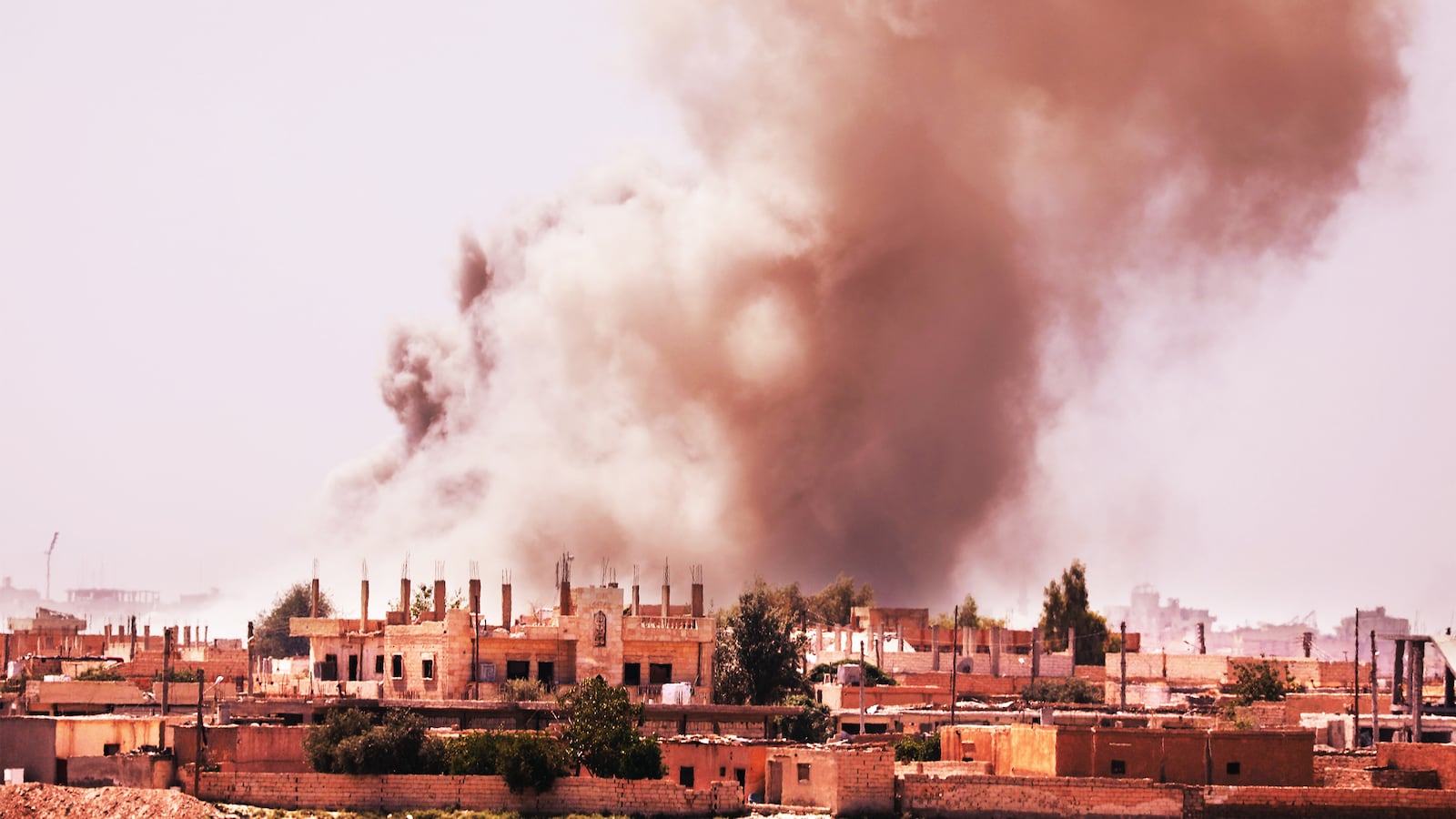ISTANBUL—The U.S.-led bombing and shelling of Raqqa, the city claimed by the so-called Islamic State as its capital in eastern Syria, is destroying entire neighborhoods but doing nothing for desperate residents and those trying to flee for their lives, according to a well-known human rights group that reports on the situation there.
The assault began June 6 with the U.S. declaring its goal as the annihilation of ISIS extremists there. As of Tuesday, the U.S.-led Coalition had carried out 262 airstrikes against the city, with that onslaught augmented by heavy artillery barrages.
“The people of the city describe the situation as Doomsday,” the group, Raqqa is Being Slaughtered Silently, reported on its web blog. The organization sometimes known by its initials, RIBSS or RBSS, has won worldwide renown for surreptitiously gathering reports on the plight of the mostly Arab civilian population suffering under the rule of the self-proclaimed “Caliphate.” ISIS has responded by hunting down and murdering RIBSS members, and today the group operates under cover.
“The population are in a state of chaos and don’t know which neighborhoods to go to for better protection,” it said in the posting one week ago. “Hundreds of shells and bombs fall on the city arbitrarily every day,” and heavy machine fire “reaches most of the neighborhoods” in the ISIS-held parts of the city.
Surprisingly, the militia serving as the U.S. proxy ground force, the Kurdish-led Syrian Democratic Forces, has taken relatively few casualties. Through last Friday, the SDF said 312 ISIS fighters had been killed in the operation, and numbered its own losses at 15, many from ISIS car bomb attacks. The U.S. estimated the ISIS force at 2,500 at the start of the operation.
SDF’s low losses reflect the fact there has been little or no house-to-house fighting, according to a spokesman for Raqqa is Being Slaughtered Silently.
“The international Coalition warplanes usually sweep a whole area of the city and destroy everything with the help of artillery shelling. Then ISIS withdraws from the neighborhood, and the SDF advances into it,” Firas Hanoush, a member of the RBSS leadership, told The Daily Beast.
The SDF said as of June 12 it had captured all or most of five of the city’s 24 neighborhoods. At least two, Al Sinaa and Battani, were destroyed in the process, according to Hanoush. He said the U.S.-led Coalition had used the same technique in the Raqqa countryside, where it bombed villages, forcing ISIS to leave, and only then did the SDF walk in, hoist its flag—and order the population to leave.
“This is very similar to the Vietnam war, where entire cities were destroyed,” said Hanoush. “What is happening in Raqqa is like dropping a nuclear bomb in stages.”
Journalists face a major challenge in covering the Raqqa operation. While U.S. troops are on the ground at the battlefront, guiding and supporting the SDF, the Pentagon has not embedded reporters to permit first-hand accounts of what’s happened. The U.S. Central Command daily publishes terse statements about the number of airstrikes, but there are no photographs from ground or air to show the level of destruction.
Hanoush, like many of his RIBSS colleagues, is now living in Europe. In a phone interview he charged that the U.S. had no plan to evacuate the estimated 100,000 people still left in the city. (Some 300,000 residents fled the city in advance of the operation.) “Simply put, there is a complete lack of an emergency plan to evacuate the civilians,” he said.
A State Department official said the U.N. had issued a plan last November and updated it in January, laying out potential displacement scenarios as well as response capabilities on the ground.
But U.N. reports point to a “dire” situation inside Raqqa, chaotic conditions in camps for internally displaced persons (IDPs), and abusive treatment of IDPs on the way to and inside the camps.
No one—the U.N., the U.S. military, the SDF or the RIBSS volunteers—appears to have a count of civilian casualties since the operation began.
The Istanbul-based Syrian Opposition Coalition, consisting of the leadership of moderate political forces, said its own monitoring team, using its own sources inside and outside of Raqqa, including newly arrived displaced persons at various camps, agrees completely with the RIBSS judgment of the damage to the city and its infrastructure.
Fares al Ali of the Coalition monitoring group said 19 Raqqa neighborhoods had been bombed and shelled, and the destruction level in some locations, such as Al Rumanya, may be as much as 80 per cent.
Another Turkey-based Raqqa activist, Sunbhi Sukkar, estimated that the U.S.-led bombing and shelling had destroyed 40 per cent of the city’s neighborhoods.
The Daily Beast on Tuesday requested photos from the Pentagon of the level of destruction in several neighborhoods, but there was no response at the time of publication.
The U.N. in a report Monday (PDF) said fuel and food were becoming scarce in the city, the water supply had been halted, and there was limited electricity. Most bakeries were out of service as they lacked flour and diesel fuel, mobile communications had been severed because the communications had been bombed. Other human rights groups reported that bakeries had been destroyed by shelling or bombing. Bread is the staple food in the region.
When asked what the Coalition was doing to feed the population, a spokesman for the broad offensive dubbed Operation Inherent Resolve responded that its mission “is to defeat ISIS in Iraq and Syria.” The emailed response cited a number of steps to improve the situation in IDP camps but nothing for the 100,000 residents of Raqqa.
Some of the camps, notably Ayn Issa, a scene of chaos and severe scarcity just two weeks ago, now have regular medical services, and many NGO’s are present and active, according to Abdulsalam Hamsork, an official for the Kurdish political party which controls the Kurdish region, and who works in the camp.
He said IDPs arriving from Raqqa reported the destruction there is “huge” because ISIS had dug many tunnels, prepared itself well for battle and is hiding in the suburbs of the old city. “It takes a lot of bombing to get ISIS out of a certain suburb,” he said.
The U.N. report noted the absence of a major population group—men between the ages of 18 and 40. It said this was reportedly due to a fear they would be forcibly conscripted, arrested or detained by the SDF. The U.S. military apparently has little concern about the actions of its SDF partners on the ground in this regard. Asked about another example of the SDF forcibly conscripting Arabs in Hasakah province, the operations spokesman advised The Daily Beast to “contact the respective groups or governments in those areas for comment.” He reiterated: “The mission of the Coalition is the defeat of ISIS in Iraq and Syria.”
Yet another reason IDPs may fear the Ayn Issa camp is that the SDF has installed Hasan Al Salem, also known as Abu Al Yaman Al Raqawi, a former ISIS security official who defected to the SDF on the eve of the operation. According to Hanoush of Raqqa is Being Slaughtered Silently, Raqawi is feared by Raqqa residents because he is alleged to have carried out field executions of Raqqa civil society activists in the past. “He’s now working for the counter-terrorism unit with the SDF, in charge of recognizing ISIS elements among the IDPs,” Hanoush said.
Raqawi was also known to the Syrian Coalition’s Fares Al Ali. “He’s a powerful authority at the camp now,” he said. “People fear him.”
Abdulsalam Hamsork, the Kurdish political official at Ayn Issa camp, said he’d “heard of” Raqawi, but wouldn’t confirm or deny the reports about him. “Security issues are beyond my authority,” he said.






